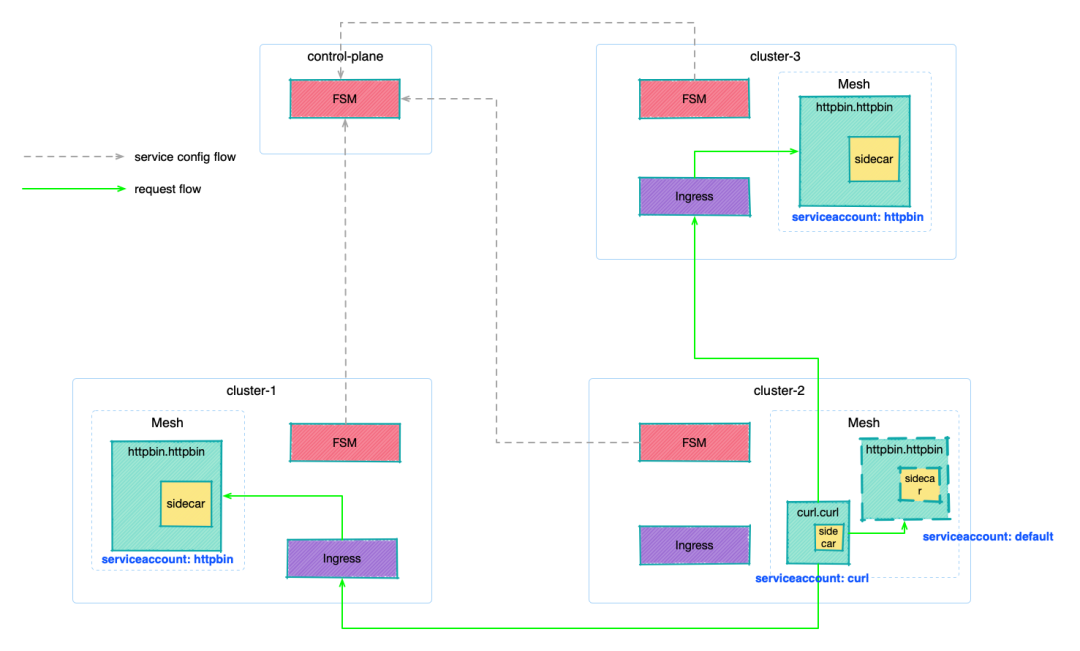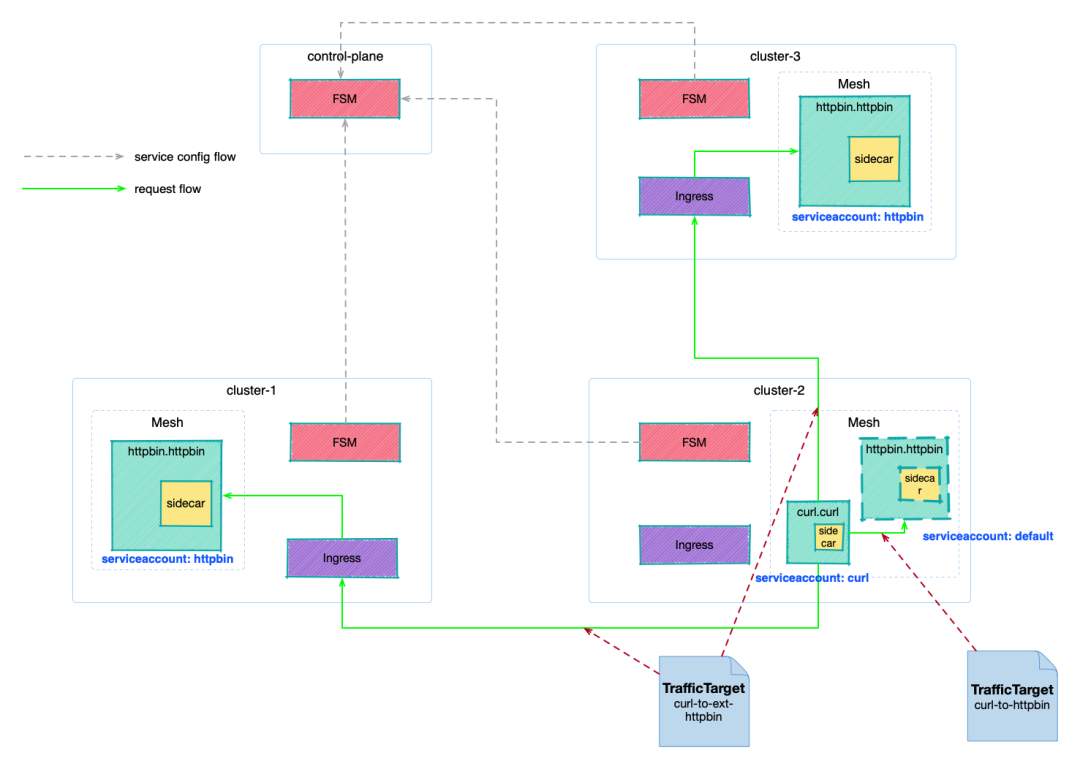背景
众所周知,Flomesh 的服务网格产品 osm-edge[1] 是基于 SMI(Service Mesh Interface,服务网格接口) 标准的实现。SMI 定义了流量标识、访问控制、遥测和管理的规范。在 上一篇 中,我们体验过了多集群服务(Multi-Cluster Service,MCS),以及流量在多集群中的调度策略,属于最基本最基础的能力,这篇会带大家体验一下基于 SMI 实现的跨集群访问控制。
在开始之前,先回顾一下 SMI 访问控制的规范[2]。在 osm-edge 中的 流量策略有两种形式[3]:宽松模式 和 流量策略模式。前者允许网格中的服务互相访问,后者需要提供相应的流量策略才可以访问。
SMI 访问控制策略
在流量策略模式下,SMI 通过 CRD TrafficTarget 来定义基于 ServiceAccount 的访问控制,其中定义了流量源(sources)、目标(destinations)以及规则(rules)。表达的是使用 sources 中指定 ServiceAccount 的应用可以访问 destinations 指定 ServiceAccount 的应用,可访问的流量由 rules 指定。
比如下面的示例,表示的是使用 ServiceAccount promethues 运行的负载,发送 GET 请求到使用 ServiceAccount service-a 运行的负载的 /metrics 端点。HTTPRouteGroup 定义了流量的标识:即访问端点 /metrics 的 GET 请求。
kind: HTTPRouteGroup
metadata:name: the-routes
spec:matches:- name: metricspathRegex: "/metrics"methods:- GET
---
kind: TrafficTarget
metadata:name: path-specificnamespace: default
spec:destination:kind: ServiceAccountname: service-anamespace: defaultrules:- kind: HTTPRouteGroupname: the-routesmatches:- metricssources:- kind: ServiceAccountname: prometheusnamespace: default那么在多集群中,访问控制的表现如何呢?
FSM 的 ServiceExport
FSM 的 ServiceExport 用于导出服务到其他集群,也就是服务注册的过程。ServiceExport 的字段 spec.serviceAccountName 可以用来指定服务负载使用的 ServiceAccount。
apiVersion: flomesh.io/v1alpha1
kind: ServiceExport
metadata:namespace: httpbinname: httpbin
spec:serviceAccountName: "*"rules:- portNumber: 8080path: "/cluster-1/httpbin-mesh"pathType: Prefix接下来,我们在上次的环境基础上开始演示,没有看过上一篇的小伙伴可以参考 上一篇 来搭建环境。
部署应用

部署示例应用
在集群 cluster-1 和 cluster-3 的 httpbin 命名空间(由网格管理,会注入 sidecar)下,部署 httpbin 应用。这里我们指定 ServiceAccount 为 httpbin。
export NAMESPACE=httpbin
for CLUSTER_NAME in cluster-1 cluster-3
dokubectx k3d-${CLUSTER_NAME}kubectl create namespace ${NAMESPACE}osm namespace add ${NAMESPACE}kubectl apply -n ${NAMESPACE} -f - <<EOF
apiVersion: v1
kind: ServiceAccount
metadata:name: httpbin
---
apiVersion: apps/v1
kind: Deployment
metadata:name: httpbinlabels:app: pipy
spec:replicas: 1selector:matchLabels:app: pipytemplate:metadata:labels:app: pipyspec:serviceAccountName: httpbincontainers:- name: pipyimage: flomesh/pipy:latestports:- containerPort: 8080command:- pipy- -e- |pipy().listen(8080).serveHTTP(new Message('Hi, I am from ${CLUSTER_NAME} and controlled by mesh!\n'))
---
apiVersion: v1
kind: Service
metadata:name: httpbin
spec:ports:- port: 8080targetPort: 8080protocol: TCPselector:app: pipy
---
apiVersion: v1
kind: Service
metadata:name: httpbin-${CLUSTER_NAME}
spec:ports:- port: 8080targetPort: 8080protocol: TCPselector:app: pipy
EOFsleep 3kubectl wait --for=condition=ready pod -n ${NAMESPACE} --all --timeout=60s
done在 cluster-2 的命名空间 httpbin 下 部署 httpbin 应用,但不指定 ServiceAccount,使用默认的 ServiceAccount default。
export NAMESPACE=httpbin
export CLUSTER_NAME=cluster-2kubectx k3d-${CLUSTER_NAME}
kubectl create namespace ${NAMESPACE}
osm namespace add ${NAMESPACE}
kubectl apply -n ${NAMESPACE} -f - <<EOF
apiVersion: apps/v1
kind: Deployment
metadata:name: httpbinlabels:app: pipy
spec:replicas: 1selector:matchLabels:app: pipytemplate:metadata:labels:app: pipyspec:containers:- name: pipyimage: flomesh/pipy:latestports:- containerPort: 8080command:- pipy- -e- |pipy().listen(8080).serveHTTP(new Message('Hi, I am from ${CLUSTER_NAME}! and controlled by mesh!\n'))
---
apiVersion: v1
kind: Service
metadata:name: httpbin
spec:ports:- port: 8080targetPort: 8080protocol: TCPselector:app: pipy
---
apiVersion: v1
kind: Service
metadata:name: httpbin-${CLUSTER_NAME}
spec:ports:- port: 8080targetPort: 8080protocol: TCPselector:app: pipy
EOFsleep 3
kubectl wait --for=condition=ready pod -n ${NAMESPACE} --all --timeout=60s在集群 cluster-2 的命名空间 curl 下部署 curl 应用,这个命名空间是被网格管理的,注入的 sidecar 会完全流量的跨集群调度。这里指定使用 ServiceAccout curl。
export NAMESPACE=curl
kubectx k3d-cluster-2
kubectl create namespace ${NAMESPACE}
osm namespace add ${NAMESPACE}
kubectl apply -n ${NAMESPACE} -f - <<EOF
apiVersion: v1
kind: ServiceAccount
metadata:name: curl
---
apiVersion: v1
kind: Service
metadata:name: curllabels:app: curlservice: curl
spec:ports:- name: httpport: 80selector:app: curl
---
apiVersion: apps/v1
kind: Deployment
metadata:name: curl
spec:replicas: 1selector:matchLabels:app: curltemplate:metadata:labels:app: curlspec:serviceAccountName: curlcontainers:- image: curlimages/curlimagePullPolicy: IfNotPresentname: curlcommand: ["sleep", "365d"]
EOFsleep 3
kubectl wait --for=condition=ready pod -n ${NAMESPACE} --all --timeout=60s导出服务
export NAMESPACE_MESH=httpbin
for CLUSTER_NAME in cluster-1 cluster-3
dokubectx k3d-${CLUSTER_NAME}kubectl apply -f - <<EOF
apiVersion: flomesh.io/v1alpha1
kind: ServiceExport
metadata:namespace: ${NAMESPACE_MESH}name: httpbin
spec:serviceAccountName: "httpbin"rules:- portNumber: 8080path: "/${CLUSTER_NAME}/httpbin-mesh"pathType: Prefix
---
apiVersion: flomesh.io/v1alpha1
kind: ServiceExport
metadata:namespace: ${NAMESPACE_MESH}name: httpbin-${CLUSTER_NAME}
spec:serviceAccountName: "httpbin"rules:- portNumber: 8080path: "/${CLUSTER_NAME}/httpbin-mesh-${CLUSTER_NAME}"pathType: Prefix
EOF
sleep 1
done测试
我们切换回集群 cluster-2:
kubectx k3d-cluster-2默认路由类型是 Locality ,我们需要创建一个 ActiveActive 策略,来允许使用其他集群的服务实例来处理请求。
kubectl apply -n httpbin -f - <<EOF
apiVersion: flomesh.io/v1alpha1
kind: GlobalTrafficPolicy
metadata:name: httpbin
spec:lbType: ActiveActivetargets:- clusterKey: default/default/default/cluster-1- clusterKey: default/default/default/cluster-3
EOF在 cluster-2 集群的 curl 应用中, 我们向 httpbin.httpbin 发送请求。
curl_client="$(kubectl get pod -n curl -l app=curl -o jsonpath='{.items[0].metadata.name}')"kubectl exec "${curl_client}" -n curl -c curl -- curl -s http://httpbin.httpbin:8080/多请求几次会看到如下的响应:
Hi, I am from cluster-1 and controlled by mesh!
Hi, I am from cluster-2 and controlled by mesh!
Hi, I am from cluster-3 and controlled by mesh!
Hi, I am from cluster-1 and controlled by mesh!
Hi, I am from cluster-2 and controlled by mesh!
Hi, I am from cluster-3 and controlled by mesh!演示
调整流量策略模式
我们先将集群 cluster-2 的流量策略模式调整下,这样才能应用流量策略:
kubectx k3d-cluster-2
export osm_namespace=osm-system
kubectl patch meshconfig osm-mesh-config -n "$osm_namespace" -p '{"spec":{"traffic":{"enablePermissiveTrafficPolicyMode":false}}}' --type=merge此时,再尝试发送请求,会发现请求失败。因为在流量策略模式下,没有配置策略的话应用间的互访是被禁止的。
kubectl exec "${curl_client}" -n curl -c curl -- curl -s http://httpbin.httpbin:8080/
command terminated with exit code 52应用访问控制策略
文章开头介绍 SMI 的访问控制策略时有提到是基于 ServiceAccount 的,这就是为什么我们部署的 httpbin 服务在集群 cluster-1 、cluster-3 与集群 cluster-2 中使用的 ServiceAccount 不同:
• cluster-1:
httpbin• cluster-2:
default• clsuter-3:
httpbin
接下来,我们会为集群内和集群外的服务,分别设置不同的访问控制策略 TrafficTarget,通过在 TrafficTarget 中目标负载的 ServiceAccount 来进行区分。

执行下面的命令,创建流量策略 curl-to-httpbin,允许 curl 访问命名空间 httpbin 下使用 ServiceAccount default 的负载。
kubectl apply -n httpbin -f - <<EOF
apiVersion: specs.smi-spec.io/v1alpha4
kind: HTTPRouteGroup
metadata:name: httpbin-route
spec:matches:- name: allpathRegex: "/"methods:- GET
---
kind: TrafficTarget
apiVersion: access.smi-spec.io/v1alpha3
metadata:name: curl-to-httpbin
spec:destination:kind: ServiceAccountname: defaultnamespace: httpbinrules:- kind: HTTPRouteGroupname: httpbin-routematches:- allsources:- kind: ServiceAccountname: curlnamespace: curl
EOF多次发送请求尝试,集群 cluster-2 的服务都会做出响应,而集群 cluster-1 和 cluster-3 不会参与服务。
Hi, I am from cluster-2 and controlled by mesh!
Hi, I am from cluster-2 and controlled by mesh!
Hi, I am from cluster-2 and controlled by mesh!执行下面命令检查 ServiceImports,可以看到 cluster-1 和 cluster-3 导出的服务使用的是 ServiceAccount httpbin。
kubectl get serviceimports httpbin -n httpbin -o jsonpath='{.spec}' | jq{"ports": [{"endpoints": [{"clusterKey": "default/default/default/cluster-1","target": {"host": "192.168.1.110","ip": "192.168.1.110","path": "/cluster-1/httpbin-mesh","port": 81}},{"clusterKey": "default/default/default/cluster-3","target": {"host": "192.168.1.110","ip": "192.168.1.110","path": "/cluster-3/httpbin-mesh","port": 83}}],"port": 8080,"protocol": "TCP"}],"serviceAccountName": "httpbin","type": "ClusterSetIP"
}因此,我们创建另一个 TrafficTarget curl-to-ext-httpbin,允许 curl 访问使用 ServiceAccount httpbin 的负载。
kubectl apply -n httpbin -f - <<EOF
kind: TrafficTarget
apiVersion: access.smi-spec.io/v1alpha3
metadata:name: curl-to-ext-httpbin
spec:destination:kind: ServiceAccountname: httpbinnamespace: httpbinrules:- kind: HTTPRouteGroupname: httpbin-routematches:- allsources:- kind: ServiceAccountname: curlnamespace: curl
EOF应用策略后,再测试一下,所有请求都成功。
Hi, I am from cluster-2 and controlled by mesh!
Hi, I am from cluster-1 and controlled by mesh!
Hi, I am from cluster-3 and controlled by mesh!总结
MCS(Multi-cluster Service)API 的实现目标是能够像 Service 一样,使用其他集群的服务。虽然在 Kubernetes 本身实现还有漫长的路要走,但作为 SMI 标准实现的服务网格来说,可以将其视作 Service 一样来进行操作。
就如本篇的访问控制一样,SMI 的流量拆分一样也可以支持多集群的服务。预告一下,下一篇就为大家介绍多集群服务的流量拆分。
引用链接
[1] osm-edge: https://github.com/flomesh-io/osm-edge[2] SMI 访问控制的规范: https://github.com/servicemeshinterface/smi-spec/blob/main/apis/traffic-access/v1alpha3/traffic-access.md[3] 流量策略有两种形式: https://osm-edge-docs.flomesh.io/docs/getting_started/traffic_policies/
)















)


